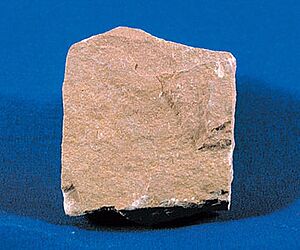Siltstone facts for kids
| Sedimentary rock | |

Siltstone
|
Siltstone, also known as aleurolite, is a type of clastic sedimentary rock. This means it's made from tiny pieces of other rocks and minerals. Siltstone is mostly made of silt, which are very small grains, bigger than clay but smaller than sand.
It's a kind of rock called "mudrock," but it doesn't have much clay minerals. You can tell siltstone apart from shale because shale easily splits into thin layers, but siltstone usually doesn't.
Even though water and gas don't easily flow through it, siltstone can sometimes hold natural gas deep underground. To get the gas out, special methods are needed.
Long ago, in ancient Egypt, siltstone was very important. People used it to make statues and special trays called cosmetic palettes. The siltstone found at Wadi Hammamat was especially good because it was hard and didn't flake easily.
What is Siltstone?
There are a few ways to define siltstone. One common idea is that it's a mudrock where at least two-thirds of the tiny particles are silt-sized. Silt particles are usually between 2 and 62 micrometers (μm) wide. To give you an idea, a human hair is about 70 micrometers thick!
Another way to define siltstone is simply any sedimentary rock that has 50% or more silt-sized pieces.
You can often tell siltstone from claystone (a rock made mostly of clay) by touching it. If you chew a tiny piece, claystone feels smooth, but siltstone feels a bit gritty, like fine sand.
Siltstones are different from sandstones because their tiny holes (pores) are much smaller. They also tend to have more clay mixed in. Even though siltstone is sometimes confused with shale, it doesn't have the thin layers or the easy splitting that shale does. Siltstones might also contain concretions, which are hard, rounded lumps of mineral matter.
If a siltstone doesn't have much shale in it, its layers might be hard to see. It also tends to break down at odd angles, not always along its original layers.
How Siltstone Forms
Siltstone is a unique rock because most of its silt grains are made of quartz. Scientists have studied a lot to understand where this quartz silt comes from. Some of it might come from certain types of metamorphic rocks. Also, some silt in the ocean might come from living things.
However, most quartz comes from rocks like granite, where the quartz grains are much bigger than silt. It takes a lot of energy to break these bigger grains down into tiny silt size. Some ideas for how this happens include:
- Grinding by glaciers (large sheets of ice).
- Weathering (breaking down) in cold, active mountain ranges.
- Normal weathering, especially in warm, wet areas.
- Formation in hot desert places by salt breaking down rocks.
Siltstones form in calm places where tiny particles can settle out of the air or water and build up on the ground. You can find them in areas like:
- Turbidite sequences (layers formed by underwater landslides).
- River deltas (where rivers meet larger bodies of water).
- Glacial deposits (left behind by glaciers).
- In certain large basins where sediments collect over time.
Where to Find Siltstone
You can find interesting siltstone formations in different places around the world:
- Cheltenham Badlands in Canada.
- Chek Chau in Hong Kong, where siltstone is layered with a rock called conglomerate.
See also
 In Spanish: Limolita para niños
In Spanish: Limolita para niños


